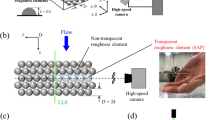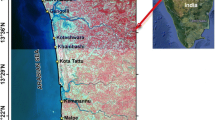Abstract
To investigate the regular patterns by wind and sand in low hilly basins, we analyzed the particle size, component end element and fractal variability of surface sediments, as well as the near-surface wind energy and sand transport potential, and determined the characteristics of their spatial differentiation in the desert west of Yinshan Mountain in China. The results showed that the regional dominant wind was mainly westerly and southwest wind, and the average annual average wind speed of sand wind was 6.56–7.62 m s–1, the annual average drift potential of the sand wind was 359.99 VU, and the average annual value of synthetic drift potential was 204.46 VU, which classified region as a the middle-wind-energy environment with middle-wind-direction variability. Under the action of dominant wind, the particle size of dune sediment gradually refined from the northwest to the southeast and northeast, and the fractal dimension gradually increased. The sediments of Baiyinchagan Desert, Boketai Desert, and southern Yamaleike Desert dunes were fine (the average particle size was 0.191 mm), and the average fractal dimension value was 2.372; the Haili Desert and the northern Yamaleike Desert dunes was large (the average particle size was 0.212 mm), and the average fractal dimension was 2.327. At the same time, fed by the near source Gobi coarse sand, under the action of long-term wind and sand, the Haili and Yamaleike Deserts formed tall and stable crescent sand dunes and sand dune chains. The particle size end member indicated that the desert sediment was wind deposit, while the desert peripheral Gobi desert end member indicated that the type of sediment was wind deposit and river alluvial material formed under the combined action of wind and water, the heterogeneity of the Gobi outside the desert was significantly higher than the desert surface, which showed moderate spatial differentiation. The topography of low mountains and hilly basins affected near-surface sandstorm processes and the formation and evolution of sandstorm landforms.











Similar content being viewed by others
References
Adam SP, Paul RB, Anders JN, Maarten AP, Andrea L (2009) Holocene paleostorms identified by particle size signatures in lake sediments from the northeastern United States. J Paleolimnol 43(1):29–49
Bullard JE, Harrison SP, Baddock MC, Drake N, Gill TE, McTainsh G, Sun YB (2011) Preferential dust sources: a geomorphological classification designed for use in global dust-cycle models. J Geophys Res 116(F4):F04034
Chen SY, Huang JP, Li JX (2017) Comparative study of sand initiation, transmission and settlement in the Taklimakan Desert and the Gobi dust. Sci Sin (terrae) 47(08):939–957
Cheng H, Jiang N, Zhang KD, Wu B, Zou XY, Zhao XM (2022) Dust emissions in the Beijing-Tianjin sandstorm source and their regional differentiation. Chin Sci Bull 68:1356–1366
Deng JF, Li JH, Deng G, Zhu HY, Zhang RH (2017) Fractal scaling of particle-size distribution and associations with soil properties of Mongolian pine plantations in the Mu Us Desert, China. Sci Rep 7(1):6742
Dong ZB, Lv P (2020) Development of aeolian geomorphology in China in the past 70 years. Acta Geogr Sin 75(3):509–527
El-Baz F, Hassan M (1986) Physics of Desertification. Springer, Dordrecht, Netherlands
Feng JX, Ding ZL, You L, Han G (2022) Wind regimes and drift potentials in the corridor of transverse dunefield in western Korqin Sandy Land. J Desert Res 42(04):110–119
Folk RL, Ward WC (1957) Brazos river bar:a study in the significance of grain size parameters[J]. J Sediment Petrol 27(1):3–26
Fryberger, S.G., Dean, G., 1979. Dune Forms and Wind Regime[M]//Mckee E D.A Study of Global Sand Sea. Ashington, USA:US Geological Survey 137–172.
Hossein B, Mostafa R, Moharram MZ, Harry V (2015) Particle size distribution models, their characteristics and fitting capability. J Hydrol 529(3):872–889
Hou K, Qian H, Zhang YT, Zhang QY, Qu WG (2021) New insights into loess formation on the southern margin of the Chinese Loess Plateau. CATENA 204:105444
Kermani S, Boutiba M (2023) Grain-size analysis and quartz surface microtextures observations of sediments from Jijelian East coast, Algeria: sedimentary environment implications. J Sediment Environ 8(2):193–208
Lancaster N, McCarley-Holder G (2013) Decadal-scale evolution of a small dune field: Keeler Dunes, California 1944–2010. Geomorphology 180–181:281–291
Lancaster N, Baker S, Bacon S, Holder G (2015) Owens Lake dune fields: Composition, sources of sand, and transport pathways. CATENA 134:1–9
Li Y, Huang CM, Wang BL, Tian XF, Liu JJ (2017) A unified expression for grain size distribution of soils. Geoderma 288:105–119
Li JY, Gao XM, Dong ZB (2021) The dataset of wind regime for yardang landforms in the Qaidam Basin. J Desert Res 41(06):265–268
Li ZZ, Jin JH, Liu R, Xie XM, Zou XJ, Ma YQ, Tan DJ (2022) Review and prospect of aeolian geomorphology research in Gurbantunggut Desert, China. J Desert Res 42(01):41–47
Liu XY, Wang HB, Zuo HJ, Yan M, Li K (2022) Fractal of the Gobi surface sediment components and its variability characteristics. CATENA 218:106525
Lu S, Tang HM, Zhang YQ, Gong WP, Wang LQ (2018) Effects of the particle-size distribution on the micro and macro behavior of soils: fractal dimension as an indicator of the spatial variability of a slip zone in a landslide. Bull Eng Geol Environ 77(2):665–677
Mandelbrodt BB (1998) Fractal geometry of nature. Shanghai Far East Publishers, Shanghai, pp 8–11
Mohammadi M, Shabanpour M, Mohammadi MH, Davatgar N (2019) Characterizing spatial variability of soil textural fractions and fractal parameters derived from particle size distributions. Pedosphere 29(02):224–234
Nicholas PW, Craig LS (2011) Soil erodibility dynamics and its representation for wind erosion and dust emission models. Aeol Res 3:165–179
Paterson GA, Heslop D (2015) New methods for unmixing sediment grain size data. Geochem Geophys Geosyst 16(12):4494–4506
Porter SC, An ZS (1995) Correlation between climate events in the North Atlantic and China during the last glaciation. Nature 375(6529):305–308
Samuel O, Akinade O (2017) Depositional environments signatures, maturity and source weathering of Niger Delta sediments from an oil well in southeastern Delta State, Nigeria. Eurasian J Soil Sci 6(3):259–274
San José Martínez F, Martín MA, Caniego FJ, Tuller M, Guber A, Pachepsky Y, García-Gutiérrez C (2010) Multifractal analysis of discretized X-ray CT images for the characterization of soil macropore structures. Geoderma 156(1):32–42
Shen YP, Zhang CL, Wang DR, Wang XS, Cen SB, Li Q (2020) Spatial heterogeneity of surface sediment grain size and Aeolian activity in the Gobi desert region of northwest China. CATENA 188(C):104469
Shi Z, Li Y (2006) Application of geostatistics in soil science. China Agricultural Publishing House, Beijing, pp 3–9
Song J, Chun X, Bai XM, Si QBLG (2016) Review of grain size analysis in China Desert. J Desert Res 36(03):597–603
Su LD (2020) Analysis on the dynamic changes of desertification in Ulat Houqi from 1986 to 2019. Inner Mongolia Agricultural University, Berlin
Udden JA (1898) The merchaninal composition of wind deposits. Augustana Library Publications, Illinois, 3(1): 1–69
Wang XM, Zhang CX, Wang HT, Qian GQ, Luo WY, Lu JF, Wang L (2011) The significance of Gobi desert surfaces for dust emissions in China: an experimental study. Environ Earth Sci 64:1039–1050
Wang XM, Liang LL, Hua T, Zhang CX, Xia DS (2015) Geochemical and magnetic characteristics of aeolian transported materials under different near-surface wind fields: an experimental study. Geomorphology 239:106–113
Wang HB, Zuo HJ, Jia XP, Li K, Yan M (2021) Full particle size distribution characteristics of land surface sediment and their effect on wind erosion resistance in arid and semiarid regions of Northwest China. Geomorphology 372(1):107458
Wei L, Hu KH (2014) Study on sediment transporting characteristics of intermittent debris flows in Jiangjia Ravine. J Nat Disasters 23(02):53–60
Weltje GJ (1997) End-member modeling of compositional data: numerical-statistical algorithms for solving the explicit mixing problem. Math Geol 29(4):503–549
Xu QQ, Xiong KN, Chi YL (2021) Effects of intercropping on fractal dimension and physicochemical properties of Soil in Karst Areas. Forests 12(10):1422–1422
Yang XP, Rost KT, Lehmkuhl F, Zhu ZD, Dodson J (2004) The evolution of dry lands in northern China and in the Republic of Mongolia since the Last Glacial Maximum. Quatern Int 118–119:69–85
Young KP, Sung HP (2010) Development of a new wind-blown-dust emission module using comparative assessment of existing dust models. Part Sci Technol 28:267–286
Zhang ZC, Dong ZB, Qian GQ, Luo WY (2012) Wind energy environments and aeolian geomorphology in the western and South-Western Tengger Desert. J Desert Res 32(06):1528–1533
Zhang KC, Niu QH, An ZS, Zhang WM, Zhang H (2015) Aeolian dynamics environment near earth surface in Desert-Oasis Transitional Zone of Dunhuang Area. Bull Soil Water Conserv 35(04):8–11+17
Zhang ZC, Pan KJ, Liang AM, Dong ZB, Li XC (2019) Progress on process and mechanism of sand and dust emission on Gobi. Adv Earth Sci 34(09):891–900
Zhao CL (2001) Sedimentary petrology. Petroleum Industry Press, Beijing, pp 48–72 (253-260)
Zhao WC, Liu LW, Chen J, Ji JF (2019) Geochemical characterization of major elements in desert sediments and implications for the Chinese loess source. Sci China Earth Sci 62(9):1428–1440
Zhou N, Li Q, Zhang CL, Hua HC, Wu YP, Zhu BQ, Cen SB, Huang XQ (2021) Grain size characteristics of aeolian sands and their implications for the aeolian dynamics of dunefields within a river valley on the southern Tibet Plateau: a case study from the Yarlung Zangbo river valley. CATENA 196:104794
Zhu ZD, Wu Z, Liu S (1974) Introduction to the desert in China. Science press, Beijing
Acknowledgements
This work was supported by the National Natural Science Foundation of China (Grant numbers 42261002 and 41861001).
Author information
Authors and Affiliations
Contributions
Dear editor, the author Liu Xiya conducted field sampling and indoor experiments, and completed the data processing and analysis and paper writing process. Author Wang Haibing helped with the setting of the experimental scheme and the final revision of the paper, author Zuo Hejun helped with the revision of the paper, and author Liu Nana helped in the field and indoor experiments. In the subsequent paper guidance process, Hejun Zuo* provided the project and some data support, as well as a lot of opinions and revision work, which was of great help to this article. Therefore, I have already communicated with all the authors, and the corresponding author was changed to Zuo Hejun, and has been modified in line 14~18 in the marked manuscript. I hope the chief editor can understand it
Corresponding author
Ethics declarations
Competing interests
The authors have not disclosed any competing interests.
Additional information
Publisher's Note
Springer Nature remains neutral with regard to jurisdictional claims in published maps and institutional affiliations.
Rights and permissions
Springer Nature or its licensor (e.g. a society or other partner) holds exclusive rights to this article under a publishing agreement with the author(s) or other rightsholder(s); author self-archiving of the accepted manuscript version of this article is solely governed by the terms of such publishing agreement and applicable law.
About this article
Cite this article
Liu, X., Wang, H., Zuo, H. et al. Wind and sand environment and spatial differentiation of sediment in the west desert of Yinshan Mountain in China. Environ Earth Sci 83, 139 (2024). https://doi.org/10.1007/s12665-023-11360-w
Received:
Accepted:
Published:
DOI: https://doi.org/10.1007/s12665-023-11360-w




